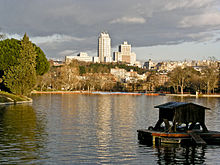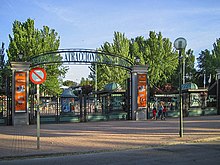Casa de Campo (park)

Casa de Campo is the largest public park in the Community of Madrid . Located west of the city of Madrid, the park is located in the Casa de Campo district , which in turn belongs to the Moncloa-Aravaca district. In the south it borders on the Latina district and in the west on the autonomous community of Pozuelo de Alarcón . The park is located on Monte de El Pardo and has an area of 1722.6 hectares , which also includes the grounds of the Club de Campo .
Before Casa de Campo was left to the people of Madrid as a recreation area in 1931, it was owned by the Spanish royal family and served them as a hunting ground. Today there are various facilities in the park, such as the amusement park of Madrid , the cable car that connects Casa de Campo with the Parque del Oeste , the Madrid Zoo as well as parts of the IFEMA exhibition center and various sports facilities.
history
Before the Habsburgs
Like the entire right bank of the Manzanares, Casa de Campo has been populated since the Paleolithic . Traces from the Neolithic are preserved to this day.
In the Itinerarium Antonini , a directory of the most important Roman imperial roads and settlements, a place called Miaccum is mentioned, which (in Roman times) is said to have been within the boundaries of the park. It is believed that the name of this settlement is also derived from the name of a stream, the Meaques , which flows through the park in the river area of the Río Manzanares.
From the 4th century onwards, the center of the Iberian Peninsula experienced a process of disintegration, which resulted in the entire area being practically depopulated with the arrival of the Arabs in the 7th century. This only changed when Muhammad I had the fortress Maǧrīṭ built in the middle of the 9th century , which is now the place of the Royal Palace.
At the end of the 14th century, Heinrich III. the area around the high forest Monte de El Pardo to his ruler's seat. A number of local aristocratic families consolidate their power by buying land in the vicinity. All of this played a key role in the decision to make Madrid the capital city two centuries later.
One of these families were the "Vargas", one of the oldest noble families of medieval Madrid, who acquired a village on the right bank of the Manzanares, including lands that reached as far as Carabanchel and that include today's Casa de Campo.
The Habsburgs
In 1519 Francisco de Vargas, a member of the Consejo de Castilla (Council of Castile) at the time of the Catholic Kings , built a country house (Spanish casa de campo) on the lands that his family owned on the other side of the Manzanares.
Before the royal court was finally relocated to Madrid in 1561, Philip II , who was still living in Brussels, had ensured that his future residence was isolated from the rest of the city by expropriating and successively buying land around the castle. The king, who was keen on hunting and knew about the rich hunting grounds of Monte de El Pardo, also planned further acquisitions of land between El Pardo and the castle in order to create a large forest there. With its particular proximity to the ruler's seat, this should serve the king as a preferred hunting reserve.
To achieve this, in 1559 Philip II of Brussels ordered his secretary Juan Vázquez de Molina to buy the land in the vicinity of the castle, on which the country house of Fadrique de Vargas was located. These should then be converted into the planned hunting area, the use of which should, however, be reserved exclusively for the royal family.
With a royal decree of 1562, Philip II finally appropriated the Vargas country house. During the next five years - until 1567 - the old Vargas residence was converted into a hunting lodge under the direction of the architect Juan Bautista de Toledo. He was also responsible for the later construction of the nearby gardens, known as El Reservado . The Italian gardener Jerónimo de Algora, known for his work on the gardens of the palace of Aranjuez, incorporated Muslim and Flemish and - for the first time for Spain - elements of Baroque gardens into these gardens, which will pave the way for classical Spanish gardens.
Various ponds and a canal system that is needed for their supply are constructed by the Dutchman Pierre Jasen. Some of the ponds are navigable with small boats and at least one of them, located near the lake 'Lago', was shallow enough to freeze in winter and there is evidence that Philip III. - still when the prince - skated on him.
Fiction
Paul Ingendaay wrote a novel about the Casa de Campo called Königspark .
Web links
- Parque de Atracciones de Madrid (Spanish)
- Madrid Zoo (Spanish)
Individual evidence
- ↑ https://www.hr2.de/gespraech/kulturgespraech/hr2---kulturcafe--das-kulturmagazin-am-nachwärts,id-kulturgespraech-1296.html
Coordinates: 40 ° 25 ′ 22.5 " N , 3 ° 45 ′ 21.4" W.

